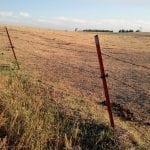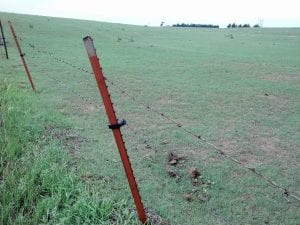By Keith Harmoney, range scientist, Hays
I was recently asked how the drought of 2022 will affect forage growth in 2023 and how drought-stricken pastures should be managed during the fall and winter prior to next growing season. These questions point me to results of a grazing study during the driest year on record at the KSU Agricultural Research Center at Hays in 1956. Looking back at 1956 and nearly 80 years of grazing studies to date, the stocking rate study being conducted that year also produced the lowest pasture yields that have been recorded at the Research Center.
In fact, grazing animals were removed in August of 1956 from the high stocking rate treatment of the study because animals simply did not have enough forage left in pastures to graze through October, the time that animals were supposed to be removed according to the study protocol. The heavy stocking rate pasture was essentially a tabletop. However, the driest year on record at Hays in 1956 was followed the next year in 1957 by an above average season of precipitation. In 1957, all of the pastures of the different stocking rate treatments in the study responded with above treatment average forage production from the above average precipitation, even in the heavy stocked pastures.
Continue reading “Learning from droughts in the 1930s and ’50s” →


 The drought that plagued most of the state through the previous winter and this summer was a perfect storm that has some operations concerned about forages for this winter. There are areas that have limited pasture growth and even with some of the recent rains, the rain may be too late or insufficient to change the pasture situation. Through last winter, around the nation, there were producers that fed more hay than typical and that has used up a significant amount of hay reserves. Given all these factors, cattle producers need to find alternative feedstuffs to maintain current cow numbers. This article will address a few things to think about when trying to stretch forages.
The drought that plagued most of the state through the previous winter and this summer was a perfect storm that has some operations concerned about forages for this winter. There are areas that have limited pasture growth and even with some of the recent rains, the rain may be too late or insufficient to change the pasture situation. Through last winter, around the nation, there were producers that fed more hay than typical and that has used up a significant amount of hay reserves. Given all these factors, cattle producers need to find alternative feedstuffs to maintain current cow numbers. This article will address a few things to think about when trying to stretch forages.  For many producers in Kansas, the last couple of weeks have brought much needed rain to our rangeland and helped fill ponds on which we depend for watering livestock. Much of central and northeast Kansas received 2 – 10 inches of rain over the Labor Day weekend. Undoubtably, the rain was welcomed by many and does much to relieve the short surface water supplies. The spring and summer of 2018 will be remembered by many cattle producers due to the hot and dry conditions that persisted. The lack of rain resulted in subpar forage production for both cool and warm season grasslands. As a result, cattle producers will face a wide range of lingering effects of the drought over the coming months and perhaps years.
For many producers in Kansas, the last couple of weeks have brought much needed rain to our rangeland and helped fill ponds on which we depend for watering livestock. Much of central and northeast Kansas received 2 – 10 inches of rain over the Labor Day weekend. Undoubtably, the rain was welcomed by many and does much to relieve the short surface water supplies. The spring and summer of 2018 will be remembered by many cattle producers due to the hot and dry conditions that persisted. The lack of rain resulted in subpar forage production for both cool and warm season grasslands. As a result, cattle producers will face a wide range of lingering effects of the drought over the coming months and perhaps years.